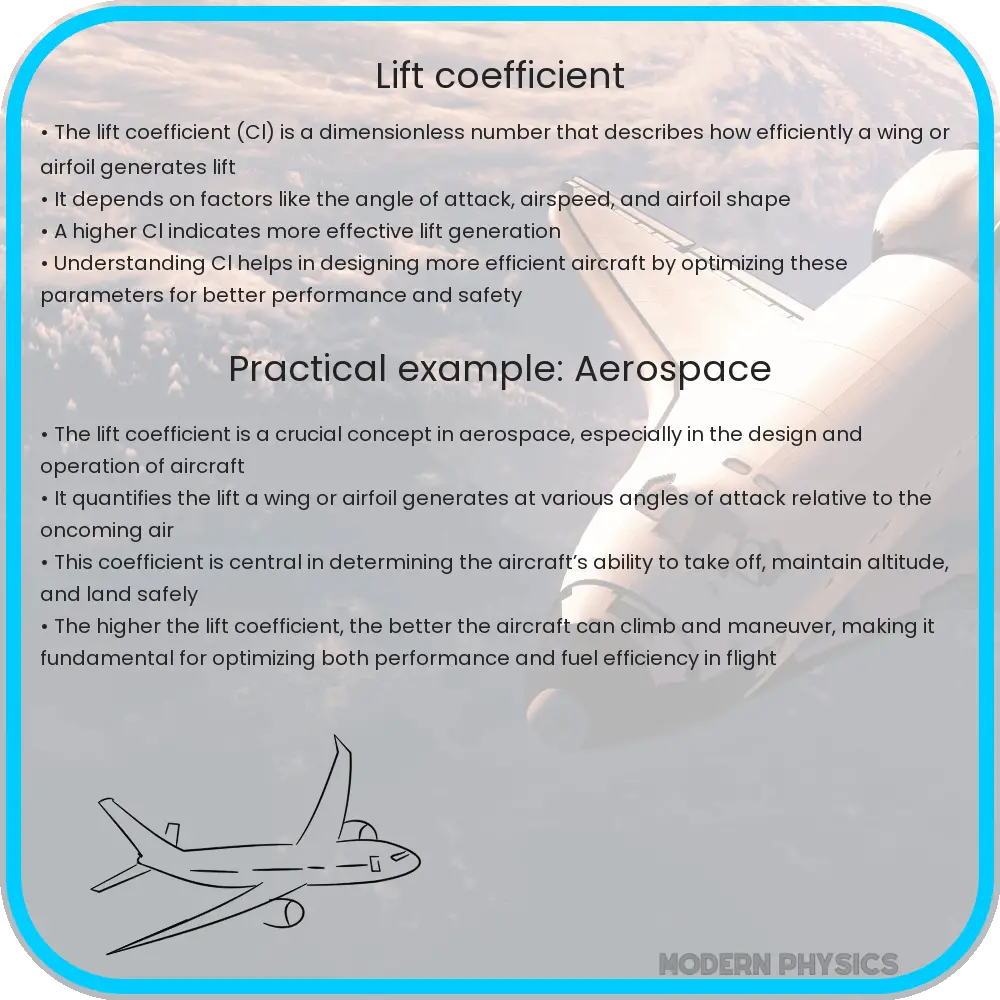Learn about the lift coefficient (C_L), a vital dimensionless number in aerodynamics used to analyse and design aircraft and vehicles by assessing lift relative to fluid density and object speed.

Understanding Lift Coefficient
The lift coefficient (CL) is a fundamental parameter in aerodynamics, critically important for designing and analyzing the performance of aircraft as well as various other applications involving aerodynamic forces. In essence, the lift coefficient is a dimensionless number that describes the lift generated by an object as it moves through a fluid relative to the density of the fluid and the speed of the object.
Applications of Lift Coefficient
Lift coefficient plays a pivotal role in several domains of engineering and physics. Primarily, it is crucial in the aerospace industry where it helps in the design and analysis of aircraft wings and control surfaces. Understanding the lift coefficient allows engineers to predict how much lift a wing will generate under different conditions, which in turn impacts the stability, control, and safety of the aircraft.
Beyond aerospace, lift coefficients are also used in automotive engineering to design the aerodynamics of vehicles, especially high-performance sports cars and racing vehicles where downforce (negative lift) is necessary to keep the vehicle stable at high speeds. Other applications include sail design in marine engineering and the development of wind turbines where understanding and maximizing lift can enhance efficiency and performance.
Measurement of Lift Coefficient
Lift coefficient can be measured in a variety of ways, but most commonly it is assessed through wind tunnel experiments or computational fluid dynamics (CFD) simulations. In wind tunnel tests, scale models of vehicles or aircraft components are subjected to controlled airflow conditions, and the lift forces are measured directly using sensors. The coefficient is then calculated by using the equation:
CL = 2 * L / (ρ * V2 * A),
where L is the lift force, ρ is the air density, V is the velocity of the airflow, and A is the reference area (typically the wing area for aircraft). In computational studies, similar parameters are used in the simulations to evaluate the lift coefficients under various conditions.
Analysis of Lift Coefficient
Analyzing the lift coefficient involves not only its calculation but also its interpretation in the context of performance and safety. For instance, by studying how the lift coefficient changes with angle of attack (the angle between the oncoming air and a reference line on the body), engineers can determine the stall conditions of an aircraft wing — a critical aspect of aerodynamic design.
Further analysis also includes examining how alterations to the shape and size of a wing or vehicle body affect the lift coefficient. This allows engineers to optimize designs to achieve desired lift characteristics while balancing factors such as weight and structural integrity. The relationship between drag coefficient and lift coefficient is also essential, as it impacts the overall aerodynamic efficiency and fuel consumption of vehicles and aircraft.
Through these measurements and analyses, the lift coefficient serves as a crucial tool in the development of efficient and effective aerodynamic designs, fostering advancements in technology and engineering across multiple fields.
Factors Influencing Lift Coefficient
Several factors can significantly affect the lift coefficient. These include the shape, size, and texture of the surface in question, as well as environmental conditions such as air temperature and pressure. For example, smoother surfaces generally reduce drag and can alter the lift coefficient favorably when paired with optimal shapes. Modifications like winglets on aircraft wings are designed to manage the lift-to-drag ratio better and enhance overall aerodynamic performance.
Moreover, the lift coefficient is not a fixed value and changes with the angle of attack and the speed of the fluid. Engineers must consider these dynamic variables during the design process to ensure stability and efficiency across the operational envelope of the aircraft or vehicle.
Challenges in Determining Lift Coefficient
Determining an accurate lift coefficient is crucial, yet it poses several challenges. Variabilities in experimental setups, such as differences in wind tunnel dimensions and air quality, can affect results. Similarly, in computational simulations, the precision of the models and the assumptions made can introduce discrepancies. Consequently, engineers often use a combination of both experimental and computational methods to verify and validate the lift coefficients obtained.
This complex process requires not only advanced technical knowledge and equipment but also a deep understanding of fluid dynamics and aerodynamics.
Conclusion
Understanding and accurately determining the lift coefficient, CL, is essential in various fields of engineering and physics, particularly in aerodynamics related to aircraft and vehicles. Its calculation and analysis allow for optimized design and enhanced performance, contributing to advancements in technology and engineering. The dynamic nature of the lift coefficient, influenced by multiple factors like shape modifications and environmental conditions, necessitates precise measurement and thorough analysis. Despite the challenges it presents, the lift coefficient remains a fundamental aspect of aerodynamic studies, driving innovation and efficiency in design processes across multiple industries.
By integrating both experimental and computational methods, engineers can continue to refine their understanding of this critical parameter, ensuring the safety, efficiency, and effectiveness of aerodynamic designs. As technology progresses, the importance of accurately evaluating the lift coefficient will undoubtedly continue to grow, influencing future developments in aerodynamics and beyond.
